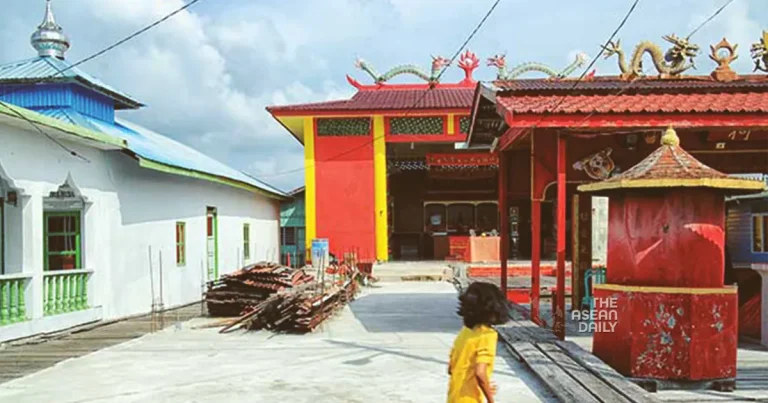2-3-2024 (JAKARTA) Tolerance and acceptance are deeply rooted in the society of Natuna District, located in the Riau Islands Province of Indonesia. The region, known for its diverse religious, ethnic, and cultural makeup, showcases a remarkable example of coexistence and harmony. At the heart of this display of unity are the side-by-side houses of worship in the Old Town of Penagi, Batu Hitam, East Bunguran Sub-district.
The Al-Mukarramah Mosque, catering to Muslims, and the Pu Tek Chi Temple, serving Confucians, stand merely two meters apart from each other. Despite their physical proximity, there have been no reported instances of discomfort or restrictions between the religious groups. For years, both communities have peacefully coexisted, providing space and respect for each other’s religious practices as dictated by their respective holy books.
The exceptional level of tolerance demonstrated in the Old Town of Penagi has earned the region the status of a Religious Modernization Village, bestowed by the Ministry of Religious Affairs. With this recognition, the hope is that the spirit of harmonious relations in Natuna can serve as a model for other regions across Indonesia, fostering inter-religious tolerance and understanding.
The cultural fabric of Natuna is equally diverse and vibrant. The majority of the population identifies as Malay and converses in the Malay language, which interestingly shares similarities with the Terengganu Malay Language spoken in Malaysia. This linguistic connection can be traced back to the region’s first leader, Datuk Kaya, who hailed from the Patani Sultanate and governed the northern parts of the Malay peninsula, including Kelantan and Terengganu.
While Malay culture thrives in Natuna, there is a welcoming atmosphere for other ethnicities to celebrate and express their cultural traditions. The local community embraces the earth alms ceremony conducted by the Javanese population in the Central Bunguran Sub-district. This annual tradition, held after a harvest, serves as an expression of gratitude to God for the bountiful yields from their fields. The ceremony is often accompanied by the Kuda Lumping dance, a Javanese art form that adds to the cultural richness of the region.
In a notable display of inclusivity, the Natuna District Government actively participates in cultural events organized by ethnicities outside the Malay community. During the August 17th Independence Day celebration in 2023, the regional government provided a platform for cultural activists from various backgrounds to showcase their arts and traditions, fostering cross-cultural exchange and appreciation. The local community wholeheartedly supported these activities, assisting participants from different cultures in obtaining materials and attire for their performances.
The spirit of tolerance extends beyond religious and cultural festivities. The people of Natuna warmly embrace holidays celebrated by different ethnic groups, such as the Lunar New Year observed by Confucians. During this time, the Chinese community decorates their temples and the surrounding streets with vibrant red lanterns. In a heartwarming display of solidarity, members of other ethnic groups actively participate in hanging the lanterns, showcasing the inclusive nature of the community.
Similarly, during Islamic holidays, individuals from various religious backgrounds contribute to the festivities. Muslim customers are often gifted carbonated and canned beverages by grocery store owners, allowing them to offer refreshments to visiting guests. Additionally, donations are made to youth organizations to create light installations, illuminating the city on the eve of Eid al-Fitr and Eid al-Adha.
Natuna stands as a shining example of unity amidst Indonesia’s diverse religious beliefs, cultures, and ethnicities. The region’s commitment to sharing and respecting one another’s uniqueness and differences sets a powerful precedent for peaceful coexistence. As the nation continues to navigate its pluralistic landscape, Natuna serves as a beacon of hope, proving that unity and harmony are attainable through acceptance, understanding, and mutual respect.




